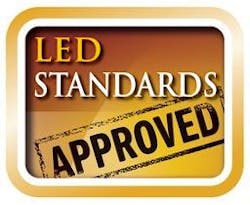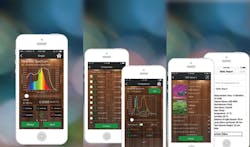JIANZHONG JIAO describes the progress being made in standards activity related to horticultural SSL applications including new metrics, a wider spectral band, and new test and measurement practices.
Interested in articles & announcements on LED horticultural lighting?
At that timeframe of the earlier article, ASABE passed a bylaw to form a new committee "Electromagnetic Radiation Application for Plants Committee" - ES-311. The purpose and scope of this committee is to lead and coordinate the activities of ASABE in matters relating to LEDs and other electromagnetic radiation source applications for plant growth and development. The committee works include: defining and describing the proper metrics of measured quantities and units; establishing methods of measurements and testing for using the proper metrics for plants; providing guides or recommendations for methods to quantify energy consumption and performance characteristics. The committee set up the objectives including to identify, document, and assist in the coordination of LEDs and other electromagnetic radiation source applications for plant growth and development; and to develop guidelines, recommendations, or standards in the related areas.
Metrics
The ASABE ES-311 Committee further formed three task forces with each charged to develop a standard document that will meet industry and society needs. The first task force focused on a standard to define and describe the metrics used for horticultural lighting. As of now, most current lighting standards are based on human sensitivity to light, which is biased positively to green/yellow light and negatively to blue and red light. Plants utilize light for photosynthesis and adjust their developmental processes - e.g., seed germination, stem elongation, and other morphogenic responses and circadian rhythms - according to light signals perceived through different photoreceptors.
Many plant biologists believe that photoreceptors absorb radiation from approximately 280-800 nm. Today, many LED lighting fixtures for horticultural applications provide the so-called broadband and continuous spectra and they are developed specifically for plants. Using human-biased lighting standards, their efficiency is low, yet from a plant perspective, their efficiency is high. Therefore, some of the current lighting standards for LEDs are not appropriate for plant applications. The task force has completed the drafted standard titled "Quantities and Units of Electromagnetic Radiation for Plants (Photosynthetic Organisms)." According to the scope, this document provides definitions and descriptions of metrics used for radiation measurements for plant (photosynthetic organism) growth, development, and production. This document does not cover display aspects and human visualization.
In over one year of document development, the draft has gone through two ballots and it is in the final finishing stage. This standard provides comprehensive information on the metrics used in horticultural applications including terminologies, quantities, and units. Because of the plant-to-optical-radiation response from the 280-800-nm wavelength range, the standard encompasses, besides the Photosynthetically Active Radiation or PAR band from 400-700 nm, the ultraviolet radiation band from 280-400 nm, and the far-red radiation band from 700-800 nm. Indeed, the entire plant response range from 280-800 nm is designated the Plant Biologically Active Radiation, or PBAR, band.
Plant biology
In this standard, the commonly used quantities for plant biological applications are grouped into two sections: radiation measurements (physics based) and photon measurements (chemistry based). With a conversion factor that includes Avogadro's number, Planck's constant, the speed of light, for any given or specific wavelength, a spectral radiant flux measured in the unit of watts per nm, a photon flux value is calculated in the unit of micromoles per second. Radiation measurements include radiant flux, radiant intensity, radiant efficiency, and all plant biology-related specifics. Photon measurements include photon flux, photon flux density, photon intensity, photon efficacy, daily light integral, and other quantities.
As for the plant response and sensitivity to radiation, it is widely recognized that different plant species, and even cultivars, respond to radiation with different sensitivities, through the processes of photosynthesis, photomorphogenesis, and photoperiodicity. However, for the purpose of defining metrics that reflect objective measurements, the standard is to have no weighting functions to be used in measuring and reporting radiant flux, photon flux, and/or irradiance.
Test and measurement
The second task force has focused on the development of a testing or measurement document, and the draft is titled "Recommended Methods of Measurements and Testing for LED Radiation Products for Plant Growth and Development." In today's practice, LED radiation products (lamps or fixtures) have been widely used in plant growth and development applications. These products have demonstrated higher effectiveness and energy-saving potential. However, standardized methods of measurements for these products have not been established.
In order to recognize the benefits of these products, the ASABE ES-311 committee believes that reliable, repeatable, and consistent test and measurement methods must be established. The standard requirements have to be refined to give clear information to plant growers about the light or radiation provided within the plant growth spectrum, and maybe some specific requirements for plant growth and applications have to be established.
Measurements for horticultural lighting and associated testing equipment have not been standardized, and this has presented a wide range of inconsistencies. Lighting equipment manufacturers would like to have consistent methods of measurement for evaluating the characteristics or properties of the products. On the other hand, plant growers would like to have reliable measurements that quantify the amount of radiation on the plant surface or photons at the plant levels.
Matching measurement to metrics
With all the metrics for the measured quantities and the units defined and described in the first standard, this second standard should provide users with methods for measuring and obtaining the defined quantities. From the lighting equipment point of view, the measurements may be divided into two levels: the lighting source (such as LEDs) level and lighting fixture level. As for the measured results, they can also be divided into two areas: single measurements and long-term or ongoing performance and changes.
In particular, if the ongoing changes effort is to reflect longevity of the product, the corresponding environmental impacts such as temperature and humidity will be considered. In the past few years, the standard development work performed in the IES (Illuminating Engineering Society) Testing Procedures Committee and the published LM documents can be a good basis for this ASABE standard. However, in developing the application-based measurements, that testing procedure has been presented with a wide range of challenges. There have been a large variety of field measurement instruments in the plant growth community. Many of them are handheld devices. Some are spectrum measurement devices and others are intended for measuring light levels. Almost all of them are using some converting calculations with a given weighting-factor to report measured results as per human eye response, illuminance or chromaticity.
On top of that inconsistency, the uncertainty or degree of accuracy may also vary from type to type or brand to brand. In the recent ASABE ES-311 committee meetings, a smart spectrometer called the Lighting Passport from Asensetek was demonstrated (see nearby photos). This equipment presents several new measurement capabilities: One is the integration of apps with smart devices. The measured results can be transmitted via Bluetooth and viewed and analyzed remotely. Furthermore, it's operated with a specific app for agricultural/horticultural lighting that includes a single-measurement mode, a multiple-measurement mode, and a daily mode for long period observation.
The task force for developing the testing standard has been collaborating with laboratory lighting measurement experts and field measurement equipment makers whose needs are both essential to the industry.
Performance standard
With the progress made in writing the metrics and testing standards, the third task force was formed to develop a performance standard. Plants, with their photosynthetic and photomorphogenic transduction biochemical pathways, require an electromagnetic radiant environment that differs in significant ways from the needs of people or animals. Key questions include: What is the effect of electromagnetic radiation? What should be the efficiency of such radiation in generating horticultural lighting products? And how efficient should these products be in terms of energy consumption?
In order to address these questions, there is a need to establish a performance measurement standard for the electromagnetic radiation system. These measures are different from the measures of human eye response to the light, such as luminous efficacy, CCT, CRI, etc. The purpose of this standard is to provide users with guidelines for appropriate performance measures and design characteristics for the electromagnetic radiation system used for plants. These measures may be able to characterize effectiveness, efficiency, and energy consumption.
The task force has been focused on the scope of the document, which is to provide guidance on measures for reporting electromagnetic output and efficacy of individual horticultural lighting products used for plant applications. The standard will address the products used for assimilative lighting as well as those used for photomorphogenic control, i.e., day-length extension, but it does not address operating conditions or serviceability issues. Furthermore, the task force agreed that the standard should be intended to be descriptive rather than prescriptive.
The experts in the committee are aware that not all measures are appropriate for all plant lighting systems and applications. Therefore, the document may not prescribe a specific wavelength range or weighting factor for reporting performance, but it expects that this data will be included when the performance is reported. Utility companies and energy management programs have expressed interests in categorizing horticultural lighting product energy-consumption measures, which may be used for incentivizing energy saving products. Thus an objective performance standard is necessary.
The ASABE ES-311 committee is on the right track to pave the path to standardize horticultural lighting metrics, testing, and performance. These standards will reflect the collaboration of the expertise, knowledge, experiences, and best practices from metrology scientists, product developers, plant biologists and growers, as well as energy management authorities. The results should have long-term benefits for the fast-growing horticulture industry.
DR. JIANZHONG JIAO, an internationally recognized lighting expert, is an independent consultant for LEDs and lighting technologies. He has been actively involved in LED and LED lighting standard development activities, technical conferences, and industry consortia. Currently he serves on the IESNA Testing Procedures, Roadway Lighting, Computer, and Light Source Committees. He is also vice chair of the ANSI SSL Light Source Working Groups, and at present works with many other technical organizations, groups, and symposia, in addition to being a member of the Technical Panel of Strategies in Light. He can be reached at [email protected].









